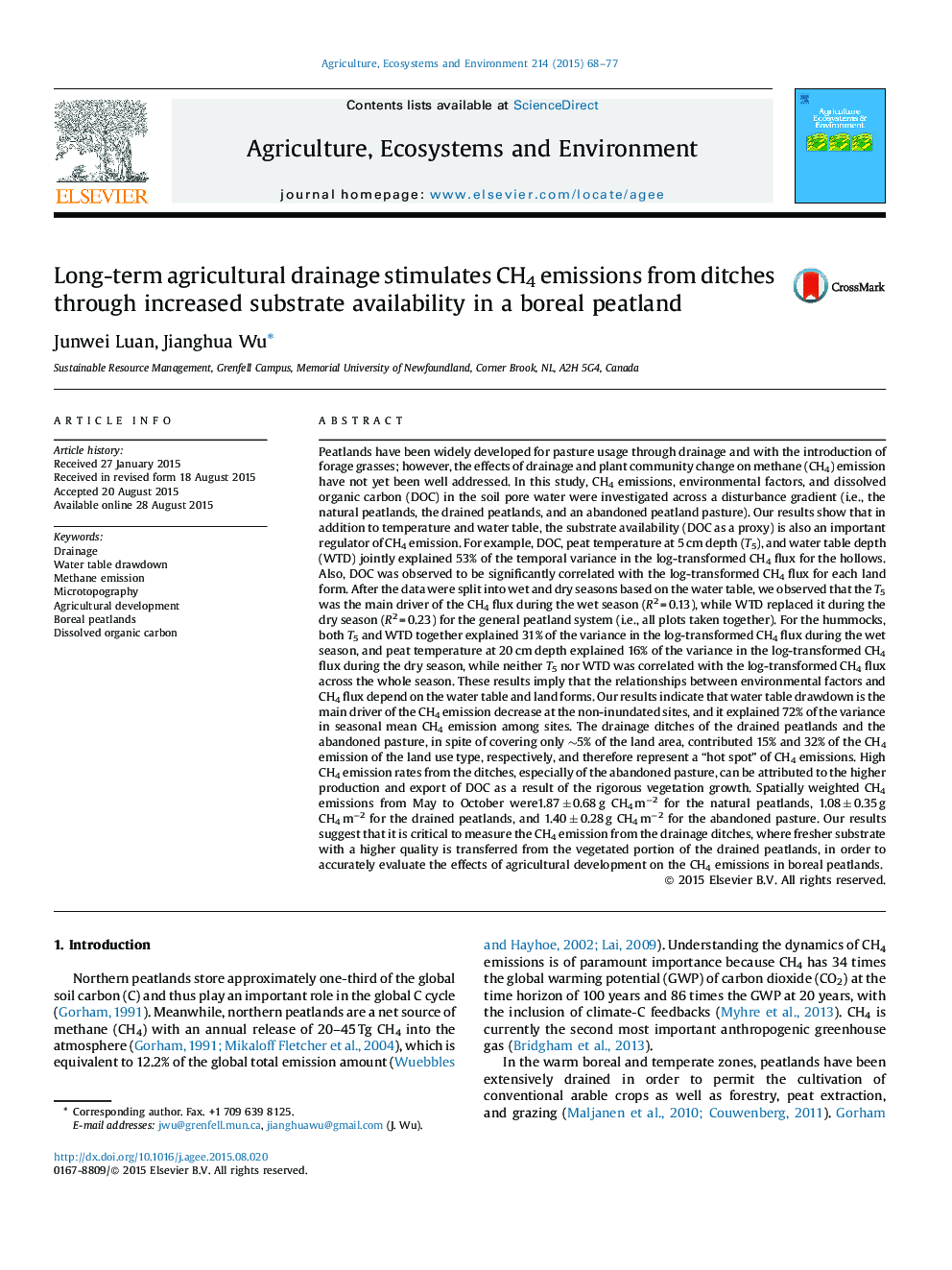| کد مقاله | کد نشریه | سال انتشار | مقاله انگلیسی | نسخه تمام متن |
|---|---|---|---|---|
| 2413612 | 1552038 | 2015 | 10 صفحه PDF | دانلود رایگان |
عنوان انگلیسی مقاله ISI
Long-term agricultural drainage stimulates CH4 emissions from ditches through increased substrate availability in a boreal peatland
دانلود مقاله + سفارش ترجمه
دانلود مقاله ISI انگلیسی
رایگان برای ایرانیان
کلمات کلیدی
موضوعات مرتبط
علوم زیستی و بیوفناوری
علوم کشاورزی و بیولوژیک
علوم زراعت و اصلاح نباتات
پیش نمایش صفحه اول مقاله

چکیده انگلیسی
Peatlands have been widely developed for pasture usage through drainage and with the introduction of forage grasses; however, the effects of drainage and plant community change on methane (CH4) emission have not yet been well addressed. In this study, CH4 emissions, environmental factors, and dissolved organic carbon (DOC) in the soil pore water were investigated across a disturbance gradient (i.e., the natural peatlands, the drained peatlands, and an abandoned peatland pasture). Our results show that in addition to temperature and water table, the substrate availability (DOC as a proxy) is also an important regulator of CH4 emission. For example, DOC, peat temperature at 5 cm depth (T5), and water table depth (WTD) jointly explained 53% of the temporal variance in the log-transformed CH4 flux for the hollows. Also, DOC was observed to be significantly correlated with the log-transformed CH4 flux for each land form. After the data were split into wet and dry seasons based on the water table, we observed that the T5 was the main driver of the CH4 flux during the wet season (R2 = 0.13), while WTD replaced it during the dry season (R2 = 0.23) for the general peatland system (i.e., all plots taken together). For the hummocks, both T5 and WTD together explained 31% of the variance in the log-transformed CH4 flux during the wet season, and peat temperature at 20 cm depth explained 16% of the variance in the log-transformed CH4 flux during the dry season, while neither T5 nor WTD was correlated with the log-transformed CH4 flux across the whole season. These results imply that the relationships between environmental factors and CH4 flux depend on the water table and land forms. Our results indicate that water table drawdown is the main driver of the CH4 emission decrease at the non-inundated sites, and it explained 72% of the variance in seasonal mean CH4 emission among sites. The drainage ditches of the drained peatlands and the abandoned pasture, in spite of covering only â¼5% of the land area, contributed 15% and 32% of the CH4 emission of the land use type, respectively, and therefore represent a “hot spot” of CH4 emissions. High CH4 emission rates from the ditches, especially of the abandoned pasture, can be attributed to the higher production and export of DOC as a result of the rigorous vegetation growth. Spatially weighted CH4 emissions from May to October were1.87 ± 0.68 g CH4 mâ2 for the natural peatlands, 1.08 ± 0.35 g CH4 mâ2 for the drained peatlands, and 1.40 ± 0.28 g CH4 mâ2 for the abandoned pasture. Our results suggest that it is critical to measure the CH4 emission from the drainage ditches, where fresher substrate with a higher quality is transferred from the vegetated portion of the drained peatlands, in order to accurately evaluate the effects of agricultural development on the CH4 emissions in boreal peatlands.
ناشر
Database: Elsevier - ScienceDirect (ساینس دایرکت)
Journal: Agriculture, Ecosystems & Environment - Volume 214, 27 December 2015, Pages 68-77
Journal: Agriculture, Ecosystems & Environment - Volume 214, 27 December 2015, Pages 68-77
نویسندگان
Junwei Luan, Jianghua Wu,